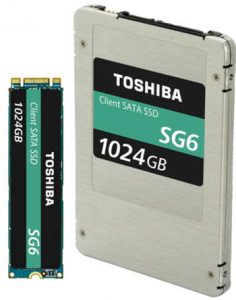Flash Memory Summit: Toshiba SG6 Series SATA Client SSDs
Utilizing 64-layer TLC BiCS flash, 2.5-Inch and M.2 2280 form factors, 256, 512 and 1,024GB
This is a Press Release edited by StorageNewsletter.com on August 15, 2017 at 2:23 pmToshiba Memory Corporation announced the launch of the SG6 series, a line-up of SATA client SSDs utilizing the company’s cutting-edge 64-layer, 3-bit-per-cell (TLC) BiCS Flash.
Sample shipments to PC OEM customers start in limited quantities, and the firm will gradually increase shipments from 4CQ17.
The SG6 series SSDs features a SATA Revision 3.3, 6.0Gb/s interface, and deliver performance of up to 550MB/s sequentiel read and 535MB/s sequential write [1]. Thanks to improved flash memory management and performance, active power consumption is cut by approximately 40% compared to previous generation products [2]. This improvement can extend battery life, a plus for applications including mobile computing.
This series will be available in three capacities, 256, 512 and 1,024GB [3]. Each capacity is aligned with two form factors: 2.5-Inch type for HDD drive upgrades; and M.2 2280 [4] type for mainstream mobile PCs. Security needs will be addressed by offering self-encrypting drive (SED) models supporting TCG Opal Version 2.01 [5].
The SG6 SSD series also supports the company’s proprietary QSBC (Quadruple Swing-By Code) error-correction technology, an ECC that helps to protect customer data from corruption and improves reliability, realizing efficient and accurate data processing.
The SG6 series was exhibited at the Flash Memory Summit 2017 in Santa Clara, CA, USA.
[1] Toshiba Memory Corporation survey based on sequential read and write speeds of 128KiB units, using 1024GB models in the SG6 series under Toshiba Memory Corporation test conditions. Read and write speed may vary, depending on the host device, read and write conditions, and file size. Toshiba Memory Corporation defines a MB as 1,000,000 bytes and a KB as 210 bytes, or 1,024 bytes.
[2] SG5 series
[3] Definition of capacity: Toshiba Memory Corporation defines a GB as 1,000,000,000 bytes. A computer OS, however, reports storage capacity using powers of 2 for the definition of 1GB = 230 bytes = 1,073,741,824 bytes, and therefore shows less storage capacity. Available storage capacity (including examples of various media files) will vary based on file size, formatting, settings, software and OS, such as Microsoft OS and/or pre-installed software applications, or media content. Actual formatted capacity may vary.
[4] The form factor of the 256GB and 512GB models is M.2 2280-S2 and for the 1024GB model it is M.2 2280-D2.
[5] Availability of the SED model line-up may vary by region.















 Subscribe to our free daily newsletter
Subscribe to our free daily newsletter

